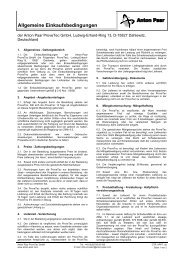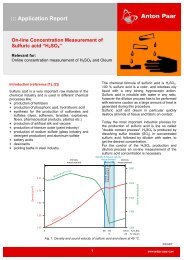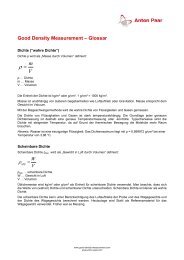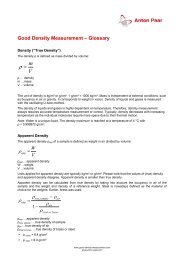L-Vis 510: STARCH ADHESIVES - Anton Paar.com
L-Vis 510: STARCH ADHESIVES - Anton Paar.com
L-Vis 510: STARCH ADHESIVES - Anton Paar.com
You also want an ePaper? Increase the reach of your titles
YUMPU automatically turns print PDFs into web optimized ePapers that Google loves.
::: Application Report<br />
L-<strong>Vis</strong> <strong>510</strong>: <strong>STARCH</strong> <strong>ADHESIVES</strong><br />
Measuring the dynamic viscosity of starch adhesives<br />
in the paper and packaging industry<br />
Current Facilities Using L-<strong>Vis</strong> <strong>510</strong><br />
The facilities in which L-<strong>Vis</strong> <strong>510</strong> is currently used include,<br />
but are not limited to, paper box and corrugated cardboard<br />
box and other corrugated cardboard manufacturers.<br />
L-<strong>Vis</strong> <strong>510</strong> is currently installed in adhesive applications for<br />
the corrugated cardboard industry in both the adhesive<br />
batch tank and the ring loop.<br />
Fig. 2: L-<strong>Vis</strong> <strong>510</strong> in a typical bypass installation in a<br />
circulation loop<br />
Corrugated Cardboard Production<br />
In the production of corrugated cardboard, the starch<br />
adhesive is produced batchwise. Its quality is controlled<br />
via the final viscosity. L-<strong>Vis</strong> <strong>510</strong> is installed in the batch<br />
tank wall (or optionally in a bypass).<br />
Fig. 3: Starch adhesive in a corrugated cardboard facility<br />
C82IA003EN-A<br />
2<br />
In the production of corrugated cardboard, single-point<br />
and/or multi-point circulation loops continuously transport the<br />
starch adhesive to and from the cardboard machines. L-<strong>Vis</strong><br />
<strong>510</strong> is installed in the pipe (or optionally in a bypass) right<br />
before the cardboard machine.<br />
Fig. 4: Single-layer cardboard process<br />
Benefits<br />
The benefits of continuous inline measurement of viscosity<br />
during production are:<br />
� Real-time, continuous quality control and assurance<br />
� Repeatable adhesive batch quality<br />
� Prevention of loss of product<br />
� Reduction of production downtime<br />
� Increased production and profitability<br />
� Automation of the adhesive blending process<br />
Application Data<br />
<strong>Anton</strong> <strong>Paar</strong> has collected numerous data to determine the<br />
flow curve, the viscosity stability related to time and<br />
temperature, overall repeatability and how viscosity reacts<br />
to blending of different starch concentrations. Please see<br />
the following graphs for more detail.












